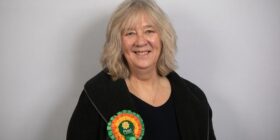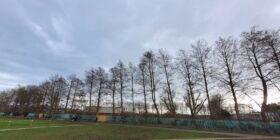Dean Road Q&A with University’s Vice-Chancellor: “It was rejected in one place, we take it to the next place”
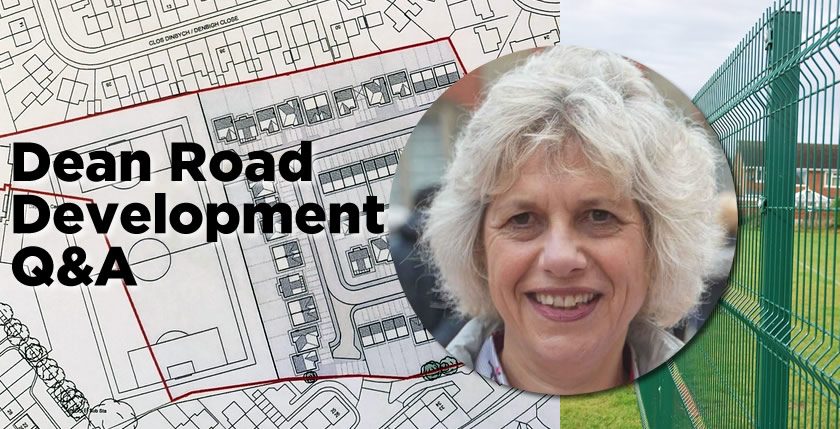
The vice-chancellor of Wrexham Glyndwr University has defended a controversial decision to try to use land in Rhosnesni for housing – and stated that an appeal to overturn the planning committee’s decision to reject the proposals is taking place.
Earlier this week Wrexham.com sat down with Wrexham Glyndwr University’s Vice-Chancellor Professor Maria Hinfelaar to discuss the proposed Dean Road development.
The university lodged a planning application for up to 74 houses on playing fields on Dean Road, which was refused by the council’s Planning Committee. The proposals created anger with some local residents, with protests held against the plans, with feelings amplified when the university placed signage and then fenced off an area of the field.
We examined a range of views, questions and points raised by readers and protest groups and collated a set of questions and put them direct to the Vice-Chancellor. Some included basic fact checks of more ‘personal’ facts and opinions. For example Prof Hinfelaar does live locally in Wrexham rather some social media speculation (and we are told half of the senior team live in and around the area), and we asked her views on such a proposal if it was at the bottom of her garden.
Starting at the beginning we enquired on the history of the playing field on Dean Road, with it apparently ‘gifted’ at some point in the 1990’s from Clwyd County Council to the then North East Wales Institute of Higher Education (NEWI), which evolved in 2008 to the university we know today.
Prof Hinfelaar said, “In 1998 it was gifted to us by Clwyd County Council. Anybody can see that and verify that because that will be with the land registry that will still be still be lodged there somewhere. It was basically gifted on the basis that there might be further development needs of the university.
“We were not the University at the time, we were still NEWI, which at the time was just being formed from a collection of different colleges and buildings, some of which weren’t so good. So I suppose the view at the time was, this is a piece of land, which might at some point be useful for the university, either to to develop something there or to help it develop elsewhere and that that was not specified.”
With various rumours and references to restricted use of the land by covenants, we asked if the university would make any deeds or covenants public so that can be verified.
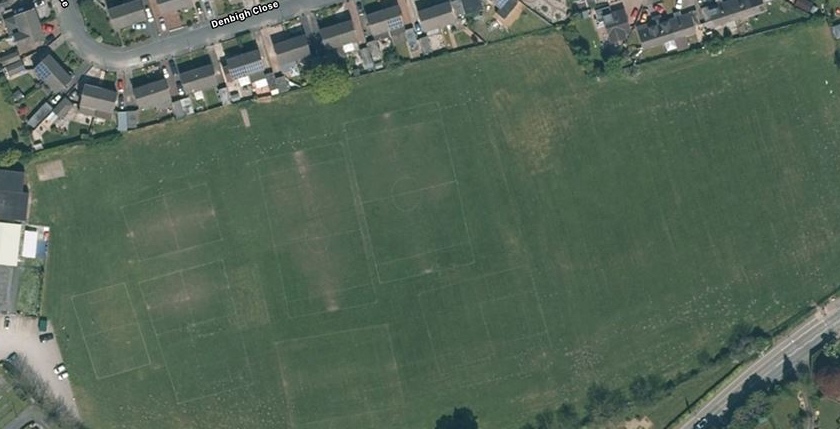
Professor Hinfelaar pointed people to the £12 Land Registry service, stating: “It sits with the land registry, that’s the central repository for these documents. We would have a copy, but it’s there too. We’re not hiding anything.”
We pointed to one person mentioned in the planning meeting the belief the land was was handed over at the time for educational and sporting use specifically. We queried if that was the case.
“There was no specific restriction on what the use might be. It was for use of NEWI as an educational institution”, said Prof Hinfelaar.
“Now, that can mean different things. So it didn’t say it can only ever be used for sport of education. But it can be for educational purposes for the development of NEWI.”
Talking about the historic land transfer, we pointed out it was ‘gifted’ for nothing. We asked Prof Hinfelaar that if there was now a capital receipt from a land sale if the money was morally the university’s to get, or should it go back to the local authority as that was the initial source of the land.
Prof Hinfelaar replied: “If you were to follow that logic, and then you could also see this main campus at some stage, back the mists of time, would also have been gifted to what is now the university by the Local Education Authority.
“There used to be different structures, with NEWI and then all the other colleges, and they fell under the local authority, governance.
“Now, that all changed in the 1990s, well before my time, and then higher education institutions became the responsibility of Welsh Government, and any of their assets became their own. So it was really in the mix of all of that.
“If you were to follow the logic it was gifted than the 90s, so therefore at any point in time the community wishes to take it back, so to speak. We might as well say, none of this, the university buildings wouldn’t then be our own, either. The same would be true of Coleg Cambria, the same will be true the University of Chester and so on. So that actually doesn’t make a lot of sense.
“Of course we know that it has been used by the community. But we’d always made it clear through the signage that’s been up there for years, that we were allowing it to be used for recreational purposes, but that permission could be withdrawn at any point in time or words to that effect.
“That was always clear. We know it’s being used by the community and that’s why we came up with the proposal as part of our planning application, that we would still retain one third of our site for use by the community, specifically Borras Park Albion because they are the principal user.”
The term ‘profit’ is one that evidently annoys the university. Referring to comments along the lines of ‘the university is out to make a profit’, we were told: “We’re not actually, this is where investment in facilities for our students, were not a profit making entity. It is inaccurate. The word profit doesn’t enter into it at all.”
With the signage being raised we pointed out that it had rankled people quite badly, and asked if that was a direct response to anything in particular, and what the process was that ended up with it being placed around the field.
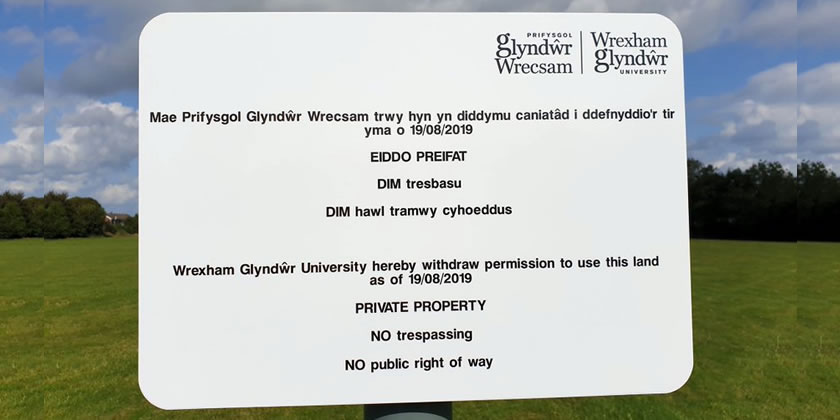
“The signage was up there previously, before the planning application, so going back quite a while,” said Professor Hinfelaar.
“The signage was always up there to say this is university property which we are making available for recreational use, but that permission maybe withdrawn at any time.
“So once the planning application have been considered by the planning committee on the first of July, It then became clear that there were some issues.
“We should point out as well, that planning application had been recommended for approval by the relevant department within the council itself, the planning officers, because in their eyes it did actually fit with what Wrexham needs in terms of housing.
“In terms of making sure that housing is built in sustainable places that people don’t have to drive everywhere. We can keep expanding and expanding out but actually, people should live locally within the town, so they can walk into town centre, they can possibly walk to work.
“So it had been recommended for approval, so when the planning application was then rejected by the planning committee, obviously, what we are going to have to do is take to appeal because we feel we have a strong case, there are very strong arguments supporting our application that didn’t just come from us. They also came from from the council who said it’s inline with national policy.
“So yes, this is a good idea, we need houses, and the fact that keeping one third (of the field) for the community is also a positive.
“So at that point in time was clear that we have a strong case to take it to appeal, that then has to be reflected in the signage that is on the site. We then decided that we need to communicate the fact that we’re now into a different stage of the process. Namely, we have a planning application that sits there with a seal of approved from from the council itself, rejected by the planning committee, we feel that the battle is half won at this stage.
“We need to see the outcome of the appeal, but in the meantime through the signage we are communicating to the public that we are no longer making available that two thirds portion of the site for recreational usage.
“We are in different territory here, we have a proposal and application with a recommendation for approval. It was rejected in one place, we’re going to take it to the next place. So we need to protect it as well, it is an asset that we now need in the state it is in, in order to bring into the next stage for the for the appeal.”

After the signage being placed, the university then took the step to fence off a section of the playing field. We pointed out that provoked a negative reaction locally, and asked if it was part of the same process, or again, a specific reason behind the erection. We were told it was ‘much quicker’ to erect signage than a fence, which ‘took a while’.
Vandalism and damage to the field has been claimed, with some signage defaced. While not condoning such defacing of signage, we asked if such a direct protest against the university could be understood, or if it was seen as a clear cut case of vandalism.
Professor Hinfelaar said: “It is vandalism. There is a definition of vandalism and it sits squarely within that definition.
“As to the motives why people are doing is that that’s another question. We have, multiple times we’ve explained what we’re doing. At the end of the day there needs to be more housing in Wrexham and so we are contributing to that.
“The development that we’re proposing is not high density, there will actually be footpaths, green space, etc, as part of the development. So it’s not as if it’s going to be a no go area once that development is complete, people will still be able to walk through it. It’s just a normal housing estate with nice new housing and plenty of space.
“Then the football pitch which will be left, which we’re talking to Borras Park Albion about, is a fairly substantial amount of space as well. So it’s the football pitch itself, plus the green space around that.”
The Dean Road site is not fully owned by the university, with a section owned by Wrexham Council. At one point it appeared the council would ‘gift’ the land to the university to join up the site. We asked what the status of such a gift was, and what the university’s view is on such an offer.
“We are proposing a license agreement, because it’s always been an informal arrangement, that even though the land has been gifted to us, as an organisation, we haven’t really done further development in any direction,” Professor Hinfelaar explained.
“Now we have specific plans for it we also need to formalise the arrangement with Borras Park Albion, because we don’t want them to be in a position where if we sell the whole site, the complete site to a developer, the developer could turn around and say ‘we’ll have green space dotted around the site in various places’ perhaps a small playing field here and some green space there, that’s no used to football club, so we wanted to protect that.
“That’s also what the fence does, it protects, it separates the the land that would be earmarked for housing development from from the green space, and that is firmly to remain as green space. So we now need to formalise that with Borras Park Albion as well. We are currently developing a license agreements with them that would that would set that out.
“Of course, there is one one small part which is owned by the council so there are three parties here. We need to make sure that that we have a clear outcome, and Borras Park Albion are not caught in the middle.
“We don’t want Borras Park Albion to be caught between when a developer eventually comes along to develop the housing, and we also don’t want them to be caught between us and the council. So we’re trying to sort that out. There are ongoing conversations.”
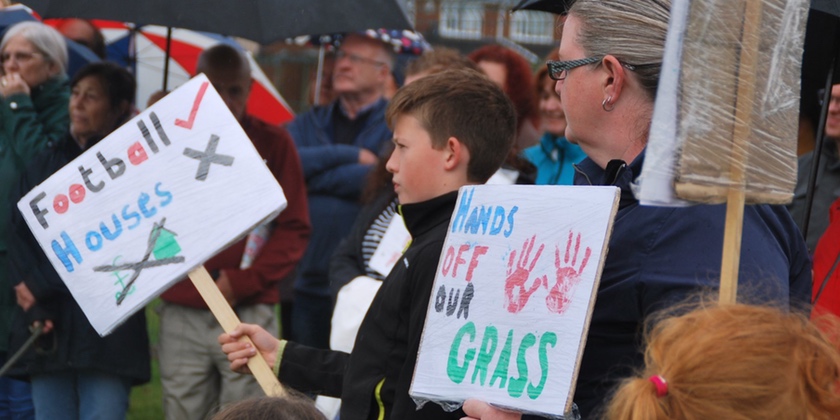
We asked if that meant there was a scenario that the university could have sold the entire plot without such a licence, split of land, or similar in place.
Professor Hinfelaar, said: “What we could have done is sold the entire plot to a developer without going to the council first with a plan.
“We could have said we’re not going to bother spending money developing this planning application, because this plan has required architectural drawings.
“We have had to do surveys, ground surveys for the wastewater, bat surveys, all of these things we have had to do in order to prepare our planning application, so we’ve encountered costs making the proposal.
“Alternatively we could have said we are not going down that route, we’re not spending a penny more on it, because of course we have been spending money maintaining it, and say we’re not going to spend money developing a planning application and will sell it to a developer as is. You know what the developer would have done the next day? Put a fence around the whole site, there would be nothing left. We would have been history by now.”
With costs being mentioned, we asked what kind of fees were being incurred, as well as details on the former maintenance of the site and subsequent fencing. We noted that figures that had been speculated about on some social media and contrasted to the savings a fence securing the field would make.
We were told the ‘grounds maintenance’ bill totalled £3,400 a year, which also saw the council owned land being maintained. That work is now being stopped although there will be some minor work to stop it becoming ‘a jungle’.
The fences cost £6276 as a one off cost, and the focus on the topic was described as a ‘side issue’ but they university were aware questions were being asked online.
The damage to signage ‘clearly doesn’t run into the thousands’ however it was pointed out time and money is spent to repair or replace them, along with ‘holes that open up again’ in fencing, ‘that are repaired using university stock, and peoples time’.
With an appeal to the local planning refusal mentioned, we enquired if the appeal had been formally lodged, and if not would one be lodged and when.
“Yes. That’s underway, well under way. It will take approximately six months altogether,” said Professor Hinfelaar.
“The appeal is essentially focuses on the original application. You can’t submit something totally different, so to some extent we will be revisiting the same arguments but in a different forum.”
Speaking about the initial planning application we used the example of the university stating there was one badly marked pitch on the playing field, however there was photographic evidence of several being marked out at one point. We asked if the annoyance, or example of lack of detail, created by perhaps minor but evidently incorrect details was something she recognised. (We had an image ready of the multiple market pitches, however it was not required.)
“No, not really, and I know the I know about the aerial picture. I think that was taken at some point in the summer, or the summer before, where there had been a tournament which was across the whole site, but that is sort of once a year,” she said.
“We would have been very happy for that to be held again this year in 2019 but for some reason didn’t go ahead, not because we had said that it couldn’t go ahead, because we knew that the fencing that we had ordered was not going up until September or whenever it was.
“On the the Borras Albion pitch, and there is a logic to where it is because that’s where the dressing room facilities are at that end, and they are not going to be playing games right in the middle, which is several hundred meters down. The pitch is a fair sized pitch, with a little space around it, definitely adequate for training purposes and games. That’s the primary pitch and always has been the primary pitch.”

With Borras Albion getting a regular mention, we asked about the communication with the residents groups and local councillor and if there were similar lines of communication.
She said: “We’ve tried. We invited all the councillors in at a very early stage, when we were still developing the planning applications to to present our ideas to them and engage in dialogue. And he didn’t show.
“We had the statutory consultation, but on top of that, we invited them in, some came along but not Councillor Mike Davies.:
In light of the Q&A session taking place and comments on communications, we asked if the university would still be up for a meeting with the councillor and others, as there is an active campaign on the issues ongoing.
Although not a direct no, it was not a quick yes: “Well, it will be good to see some factual correction of a few of the key points ahead of that.”
Recently the FAW and Glyndwr University formally opened (Wrexham.com was not allowed to attend by the FAW!) a new revamped training centre at Colliers Park. We related the ‘hypocrisy’ comments at such an opening, as it was contrasted to the planning proposals that could see a playing field built on, and thus restrict sports.
“We are not restricting sports. We are not. We are in fact making sure that come what may that is protected. So I don’t recognise that,” she explained.
“I think that its really just a very unfortunate attempt to hijack what was a very high profile event for for Wrexham, we should be absolutely jumping for joy that the fact that the North Wales training academy for the FAW is located in Wrexham, they could have gone somewhere else.
“They did look at other other sites across North Wales, we were very proactive, and its really a win win because we’re seeing huge investment at Colliers Park. Our students are using it during the week, it is a really brilliant opportunity.
“I think it’s very sad that they’ve tried to twist it in this way which puts a very negative spin on what is a real coup for for Wrexham. The opening event was brilliant, we had local schools there, we had lots of people from within the council as well, we had UEFA, FAW, players were there, it was just such a such a nice atmosphere. It’s a pity that, that the pressure group like that tries to spoil it, I can’t see what they’ve gained by doing this.”
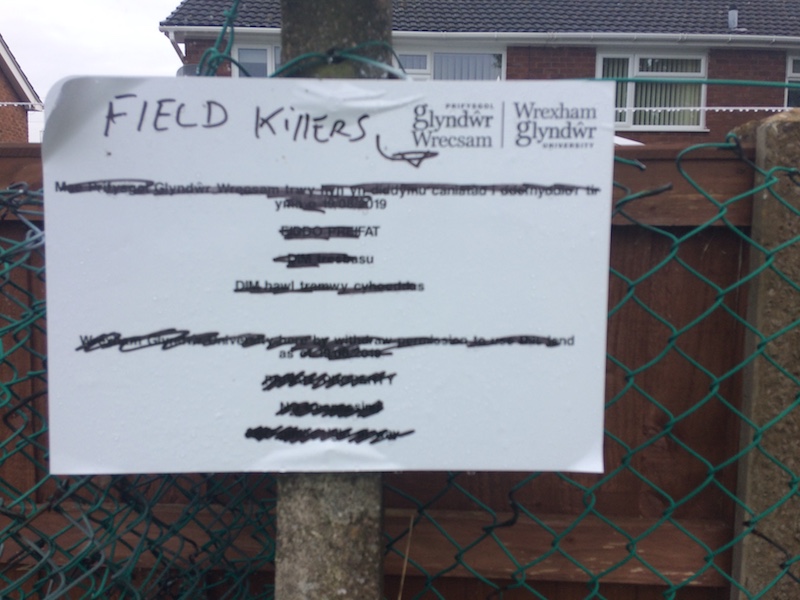
With the Q&A session taking place with the looming floodlight pylons of the Racecourse Ground in view we noted that the university was the landlord of the stadium, and noted the similarities of what in essence is also a football pitch. We asked for reassurance that there would be no similar sell of the Racecourse or anything along those lines in the future.
She said: “The Racecourse is now under the under a long term lease, which was 100 years from when was signed, so it’s in the Supporters Trust ownership.
“We’re also working with Welsh Government and the council to try and find a mechanism to invest in and restore the Kop end.
“We have a pretty good partnership with Wrexham AFC, we have some some of our students working with the club, helping them with sports performance analysis, helping them with with some of the marketing. So we have really good links there.”
Dean Road campaigners have been quite resourceful, and have been digging through the minutes of the university board. We noted one had spotted reference in 2017 to a consultants report that told the university board that the Dean Road field could be ‘rezoned’ at some point, and therefore the optimum time to dispose of the land could be before that happens. We asked if the consultants report could be made public, and what the comments referred to.
Professor Hinfelaar stated: “What that refers to is really just a general comment that the Wrexham local development plan was ongoing, and that therefore, whatever we proposed around Dean Road would need to fit in with that.
“So that is exactly what we’ve done, and the same Gatewen. We never had a consultants report around Dean Road, it doesn’t go beyond just that, it needed to tie in with the local development plan.”
We pointed out that a comment we had spotted on social media had suggested an interpretation that a sale was required sooner than later, as if any ‘rezoning’ took place a sale could not be possible.
“No. That is not the right conclusion. It is more this is a good oppertunity as Wrexham is developing its plan for housing, it was already clear that Wrexham would need to significantly increase its housing stock, and that was going to be a big part of the LDP. So it was all part of that.”
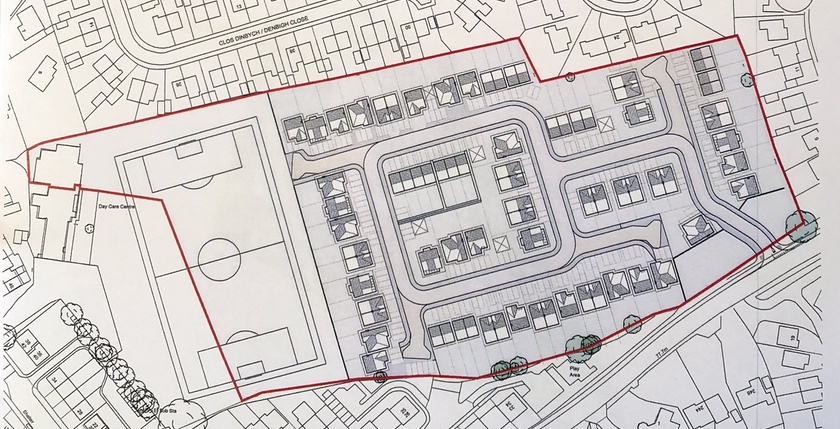
The university say they are selling off of Dean Road, and other sites, to help fund a large redevelopment of the campus. We asked what would happen if Dean Road did not sell, would it mean all plans are in jeopardy or would elements not take place or plans scaled back.
“It is one of three. There is Gatewen, and the disposal of part of the campus here where we are decommissioning some old student accommodation and also disposing of that plot of land. So there are three significant disposals. So it’s one of those three,” she said.
“Now, it’s significance. It doesn’t mean that nothing can go ahead. campus 2025 is is done in such a way it consists of different phases, which are distinct projects, we will never start a project that we cannot finish because we can’t afford to do it.
“Just to give a very simple example, one of the things we’re going to do is to create a more of a heart of the campus, we’re going to have better facilities for the student union, a more welcoming entrance and part of the campus which will also be more pedestrian friendly, because at the moment there are car parks which sort of dominate the campus.
“So we’re going to reconfigure all of that. What we clearly wouldn’t do is to develop new parts to the campus and not do the pedestrian friendly bits, we have to be able to do both. Before we start on one, we have to make sure that we do the other.
“Of course, we also don’t know yet how much we’re going to make from the sale of for instance, here the northern quarter, we don’t know how much we’re going to make from the sale of Dean Road. We need to be ambitious, but not over commit.
“Clearly, if one of the three disposals doesn’t go ahead or gets delayed, that will have implications for the phasing of campus 2025. Campus 2025 is of course important to develop the university to offer really good facilities to our students, and the vast majority of our students are from the locality.”
With local students being referenced we noted that some comments had implied such land sell offs would be creating a campus for non-local students, who may not appear. We asked if there was more detail on the make up of the students at the university.
We were told roughly 70% of students are from Wrexham, Denbighshire and Flintshire, with just under half being mature students, meaning over 21 years old when they start, with a ‘tiny proportion’ being foreign students.
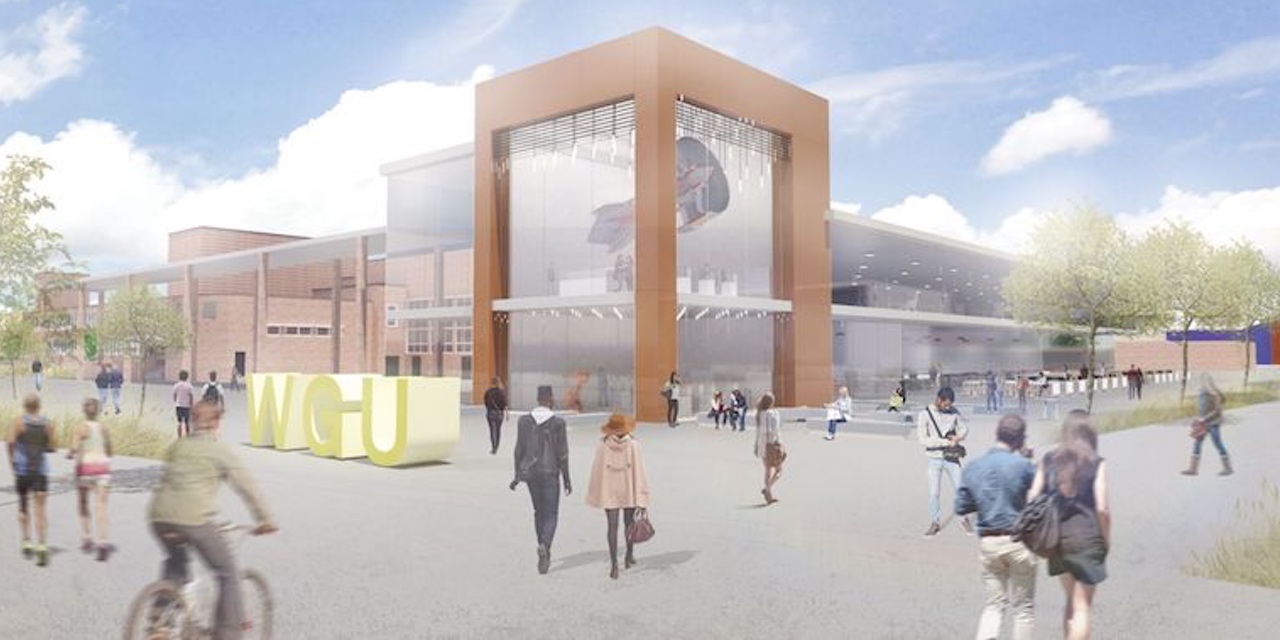
“I think one of the very important points of this in that regard is that three quarters of our students when they graduate, stay in the area and work in the area,” Professor Hinfelaar explained.
“There is a direct connection between students coming into the university, offering them the good facilities to ensure that they have a good degree, and then they work locally. It helps lift the quality of what we do in Wrexham, and the success of industry, and the success of the health sector for example.”
With the word ‘battle’ used earlier in the conversation we pointed to a comment from an Assembly Member that had said in reference to the university and Dean Road, “Any institution that forsakes its community roots is in danger of losing local support”. We asked if things had gone to plan.
“I am disappointed with some of the reaction,” she said.
“I think there is a lot of misinformation out there, which is why we’re having this conversation. So let’s start by putting some of the facts out there and correcting some of that misinformation. Then I think the jury’s out on how people view what we do.
“We do a huge amount of work in the community. We have students are volunteering, we have staff working with local community groups, whether it’s the Nightingale House, Ty Pawb, Singing Streets, you name it – we are involved. In the last few years we’ve really strengthened our links with a lot of things that go on in the community.
To wrap up we asked Professor Hinfelaar if this situation was happening around a playing field at the bottom of her garden, at a house she had lived in for many years, would she be on the side of the university or those wanting to stop the development of the playing field?
She said: “I have lived in places where there has been development of housing estates close to where I live. People have to have somewhere to live. You can’t say, ‘Well, I live in one particular place and that can never change’, as long as my garden was not taken away from me – which we are not doing!”
With the appeal being lodged against the local refusal, all eyes will now point to the Planning Inspectorate in Cardiff for what could be the final decision on the matter.
Spotted something? Got a story? Email [email protected]


